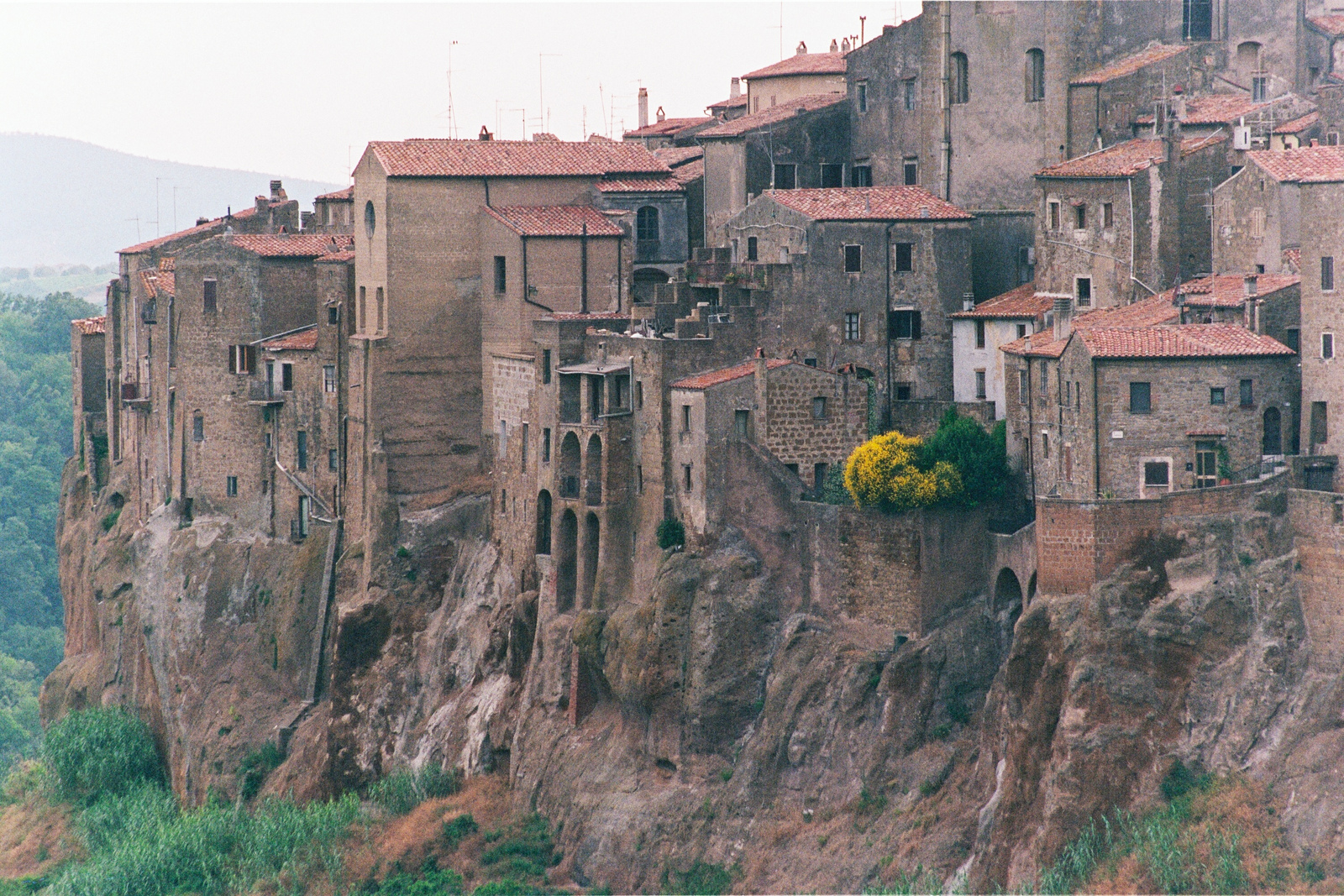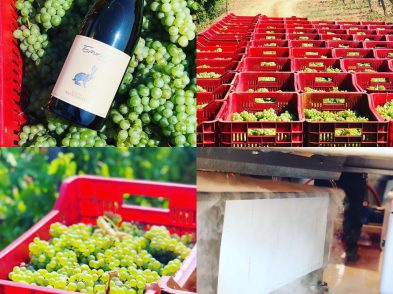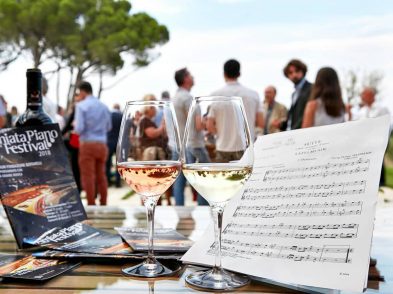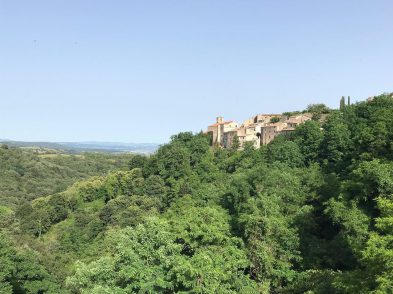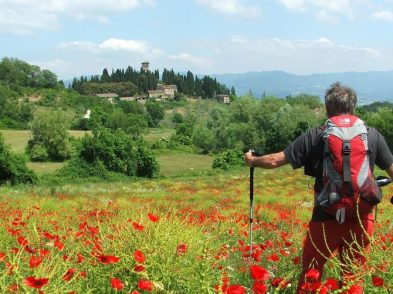In the Tuscan Maremma, Pitigliano is synonymous with enchantment and beauty, jealously and Judaism, tourism and tradition. It’s a lot for one city, but the locals are used to it. Their homes are architectural masterpieces, twisting out from their tufa cliff foundation like branches from a particularly gnarled tree. The effect is startling, especially at night, when the lights at the base of the valley bathe the entire city in a golden glow. At night, the lines that separate manmade Pitigliano from its organic base are blurred and the city looks as if it is suspended in air.
Intrepid tourists who don’t mind braving the sometimes chilly winds can see Pitigliano at its most enthralling and evocative during the town’s most important festival, the Torciata di San Giuseppe. A show of fire magnificent enough to ward off the ghosts of winter, this 600-year-old festival held on March 18, the eve of St. Joseph’s feast day, has roots in pagan celebrations of the moon and hopes for a good harvest. It starts on March 10, when Pitigliano’s young men and boys build in piazza Garibaldi a huge wooden puppet, known as l’invernacciu. Feasts and walking tours continue through the week until midnight on the 18th, when this demon-like figure with sharp teeth and angry eyes is set alight. In the dark of night, the burning puppet always puts on an unforgettable light and shadow show for the hundreds of tourists and locals who flock to the city for the event. The next day, the townsfolk ring in the new harvest with typically good food, even better wine and the sort of natural hospitality that has tourists coming back for this festival year after year.
If you can’t make it to the festival, Pitigliano has plenty to enchant at any time of year. The Maremma’s other cities begrudgingly accept that Pitigliano will always be one of the province’s most popular places. Neither its distance nor the affectionate grumblings of neighbouring Maremmani have stopped Pitigliano from becoming a must-see destination in one of Tuscany’s lesser-known areas. Because it is both beautiful and unique, most of the adventuresome tourists who visit the Tuscan Maremma make a beeline for it, marvelling at its incredible outline from the Strada Panoramica or strolling along its narrow streets, where they find an array of homemade conserves and hand-carved wooden toys.
However, what makes the tufa rock so beautiful also makes it fragile. The black and brown speckled ‘rock’ is compressed volcanic ash, easy to carve into, but even easier to destroy. Above ground, picturesque palazzos remain untouched since the Middle Ages. Modern construction has been kept to a minimum to protect these palazzos and many of the cellars that line Pitigliano have stood since the Etruscans built them more than 2,000 years ago. However, like the area’s two other tufa cities, Sovrana and Sorano, Pitigliano is a maze of crumbling streets and piazzas under today’s Pitigliano, abandoned after they sank into the cliff below.
In Pitigliano, tufa is much more than a building material; it is a source of pride. The Pitiglianese are fierce traditionalists. Their city is one of the few places in the Tuscan Maremma where a dialect is still spoken. In their dialect, the locals are called Giubbonai, a name linked to their agrarian roots and ancient farming culture. On any given afternoon, you can listen to the children playing in via Roma, screaming at each other in a dialect that only those who have lived all their lives in the town can understand.
In the sixteenth century, Pitigliano was home to a large Jewish community. Indeed, Pitigliano is also known as La Piccola Gerusalemme, or Little Jerusalem. Although it is difficult to imagine a ghetto without negative connotations, the people of Pitigliano had only the utmost respect for their Jewish neighbours. For many centuries, the city’s ghetto was left without a gate at the behest of the locals and in conscious violation of papal laws. The Jewish community contributed to every aspect of Pitigliano’s economy, society and culture. The modern city is still famous for its ‘Goym’ cooking, a cuisine that mixes Jewish and Italian flavours to create delicious treats, such as sfratto, a sweetly honeyed and spiced biscuit. You can buy this traditional delicacy from almost every bakery in Pitigliano, but the best and most authentic sfratti are made in the small bakeries that crowd the ghetto in via Zuccarelli.
In recent years, Pitigliano’s Jewish ghetto has been transformed into an inspiring museum. Like the Etruscans before them, the Pitigliano Jews carved their homes and stores directly into the tufa. To get to their wine cellars, butcher shop and even bakery, they had to walk through tunnels with walls the colour and texture of honeycomb. Today, the Museo Ebraico is open every day except for Saturday, from 10am to 5:30pm (with a suitably Italian two-hour lunch break). Tickets are 3 euro, but for an extra euro, you can get a guided tour and discover these secret tunnels and enchanting stories that have survived half a millennium. At the very centre of the ghetto is Pitigliano’s synagogue, a white and gold building that always catches the early morning sunlight. On the roof, the Ten Commandments are written in a flowing blue script that is impossible to miss.
Back out into the labyrinth of streets, Pitigliano has more treats for the visitor. In the city’s Duomo, locals amicably bicker over whether the extravagant blue, orange and brown decor is garish or grandiose, while in the much more modest and beloved Chiesa di San Marco, the coats of arms of bishops and noblemen (the Medici included) are proudly painted above the altar in a rare display of state and church relations. In piazza Garibaldi, religious treasures from throughout the Tuscan Maremma are on display at the Museo di Palazzo Orsini, the fifteenth-century castle that was once the seat of Pitigliano’s fearsome rulers, the Orsini. The museum is open every day except Mondays, from 10am to 1pm and 3pm to 6pm; tickets are 3 euro.
For something a little more bucolic, slip on a sturdy pair of walking shoes and explore the Etruscan super-communication highways, known as the Vie Cave, for free. The forests around Pitigliano are riddled with them, carved so deep into the tufa that they look more like cavernous fissures than roads (for directions ask at the Pro Loco Pitigliano, via Roma 6; tel. 0564/614433.
For visitors and locals alike, Pitigliano is the marvel of the Tuscan Maremma: a destination with a provincial spirit and ancient beauty that really is as solid as rock.
For more on Pitigliano, see http://bit.ly/ygTi4a; www.turismo.intoscana.it (in English). For more details on the Torciata di San Giuseppe, see www.comune.pitigliano.gr.it (in Italian).

